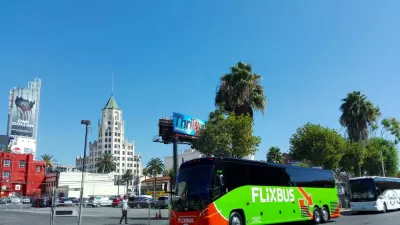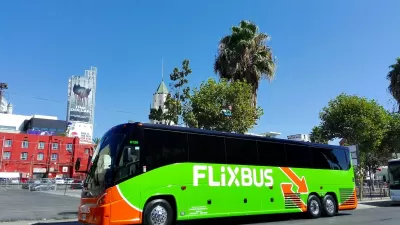As the company shutters stations, passengers are left without shelter, basic amenities, and often farther from central cities and transit connections.

Inter-city bus riders in more and more U.S. cities find themselves having to wait in outdoor parking lots or sidewalks as Greyhound continues to close many of its indoor waiting areas, reports Kea Wilson in Streetsblog USA.
The carrier has been shutting down stations since it sold its stations in 2022 following the company’s sale to Flixbus in 2021. “Some of those stops are located in suburbs miles from the core downtowns where terminals used to be located, with few transit connections for passengers who can't afford a ride to their ride.”
The move is partly a result of newer budget bus companies that purport to keep prices low by eliminating stations. “By ditching the traditional depot — and slashing thousands of station-based jobs in the process — these bus line “disruptors” were able to increase service and cut prices to the bone, even as they added amenities like onboard charging points and WiFi,” Wilson explains.
While some decommissioned stations are being converted to affordable housing and other uses, Greyhound’s core demographic will suffer from the changes. “In an era of accelerating climate change and traffic violence, shared modes like buses and trains should be our mode of first resort, especially on busy holiday travel weekends like this one, which are expected to spike 2.3 percent.”
FULL STORY: As Greyhound Stations Go Extinct, Low-Income Thanksgiving Travelers are Left Out in the Cold

Maui's Vacation Rental Debate Turns Ugly
Verbal attacks, misinformation campaigns and fistfights plague a high-stakes debate to convert thousands of vacation rentals into long-term housing.

Planetizen Federal Action Tracker
A weekly monitor of how Trump’s orders and actions are impacting planners and planning in America.

In Urban Planning, AI Prompting Could be the New Design Thinking
Creativity has long been key to great urban design. What if we see AI as our new creative partner?

King County Supportive Housing Program Offers Hope for Unhoused Residents
The county is taking a ‘Housing First’ approach that prioritizes getting people into housing, then offering wraparound supportive services.

Researchers Use AI to Get Clearer Picture of US Housing
Analysts are using artificial intelligence to supercharge their research by allowing them to comb through data faster. Though these AI tools can be error prone, they save time and housing researchers are optimistic about the future.

Making Shared Micromobility More Inclusive
Cities and shared mobility system operators can do more to include people with disabilities in planning and operations, per a new report.
Urban Design for Planners 1: Software Tools
This six-course series explores essential urban design concepts using open source software and equips planners with the tools they need to participate fully in the urban design process.
Planning for Universal Design
Learn the tools for implementing Universal Design in planning regulations.
planning NEXT
Appalachian Highlands Housing Partners
Mpact (founded as Rail~Volution)
City of Camden Redevelopment Agency
City of Astoria
City of Portland
City of Laramie





























